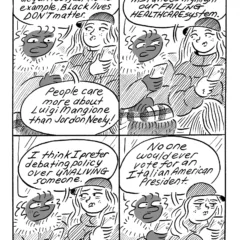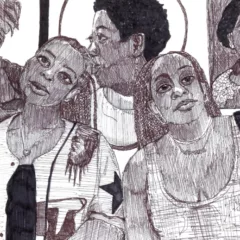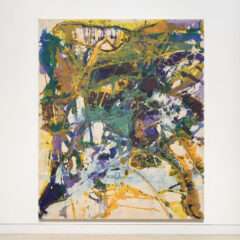The gigantic first floor space at Locks Gallery is occupied this month by the massive, multi-channel video installation 1967 by Nadia Hironaka and Matthew Suib. The collaborative project by the husband and wife team uses appropriated footage from cinema and protest videos to raise questions about political dissent, utopian movements and the role of mass media in driving protest movements in general.
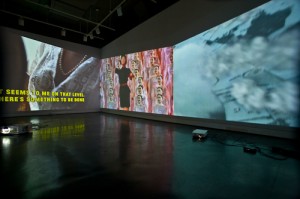
Across all the walls are floor-to-ceiling projections and interspersed amongst the few round columns in the big room are projectors, speakers, wires, headphones, and some small seats. A few flat HD monitors lie between the larger projections. Smaller, brighter, and higher resolution than their larger projected counterparts, the little monitors offer a welcomed degree of variance to the flow of moving pictures.
Some of the most immediately apparent images are those of Chinese parades and Communist regalia, some of which are glitchy and crisscrossed by rotating 3D cubes. The title 1967 is a reference to Jean-Luc Godard’s film La Chinoise which deals with a group of French students planning to change the world in a Communist revolution while studying Mao. Hironaka and Suib’s installation is a looped montage of clips from Godard’s film, original video, archival footage of the 1967 World Exposition in Montreal paired with Shanghai’s 2010 Expo, protest scenes past and present, and of course images from China’s cultural revolution.
In the wake of the Arab Spring, Occupy, and similar protest movements worldwide, the themes of this show are aptly timed to say the least. The installation acts as an intrigue into the roles of the artist and the revolutionary in society. Ideas of social orthodoxy, equality, and belief systems all come to mind. At times political upheaval is warranted, at other times dissent is quashed; sometimes revolution is widely supported, other times it happens by coup d’état. Regardless of the means for or reaction to social shifts, their inevitability looms outside the realms of political affiliation. In a universe where entropy rules, the only real guarantee is change.

As the images break down, the prevailing power structures emerge as targets of ridicule in much the same way as the protests themselves. This inherent yin-yang image of action and reaction has been similarly noted by Ram Dass in his “hippies create police/police create hippies” musing from 1971’s Be Here Now. In situations as diverse and interrelated as governing a country, it would appear that neither side has a monopoly on truth.
The characters in La Chinoise are dilettantes in a way, as young people romanticizing the concept of revolt. Much can be said about the need for economic equality or restructured government in the United States, but one also wonders how many supporters of either Ron Paul or Occupy Wall Street are on their respective bandwagons for questionable or superficial reasons. Thinking back to the beginnings of revolution in Tahrir Square, it is not hard to believe that the cinematic broadcasts on news and infotainment channels the world over helped to spur similar protests, in part, because of their excitement and danger. The mundane ennui of middle-class American youth can at least not be ruled out as a cause, in any case.
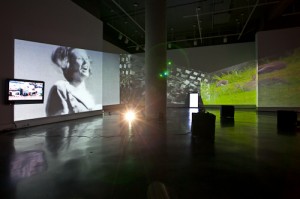
When the silly, almost childish images of roosters and other animal “comrades” are displayed on the cover of Mao’s Little Red Book in place of his idealized face, the absurdity crests and begins to give way to other relevant questions. The phrase “Is it important to take action?” appears as the game-changing caption. Of course the artists provide no concrete answers, and pose only the question. However this is arguably one of the more important responsibilities of artists: to test the waters of antithesis and throw wrenches into the gears of established social mechanisms. Artists and revolutionaries – sometimes one in the same – have quite regularly shared many similar goals such as exposing outdated concepts, offering new ways of viewing surroundings, and often subscribing to a brand of humanism with a thirst for justice and equality.
Locks Gallery’s exhibition of 1967 dissects the topic of protest in a way that only artists can. With revolution being, by its very existence, bound to its intended target, an absurd presentation seems fitting – perhaps necessary. Protest is distorted through media channels and personal interpretations, and it is certainly no science. Dogma is dogmatic regardless of political preferences. Hironaka and Suib demonstrate that, no matter what side you’re on, the complex schisms of human argument and opposition are not quite as objective and clear cut as they seem.
There will be a live performance in the installation on January 28 at 5 PM by contributing artists C. Spencer Yeh and Aaron Moore; and another reception on Feb 3. Check the website for more information and events.


